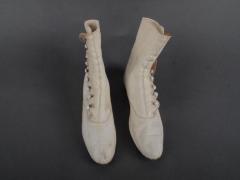Comments and Tags
Be the first to comment on this item!
Footwear
Voigt Family Collection
Clothing and Accessories ➔ Boot
Identifier:
V1218Description:
Plum-colored leather button up mid calf boot. Donated to GR Foundation 1971; purchased by Kent County Council of Historic Preservation 1974; donated to City of G.R..Date:
circa 1895 – 1905Materials:
Leather, Metallic Bead Buttons.Dimensions:
9" h 3" wCurrent Location Status:
In StorageCollection Tier:
Tier 2Source:
Gift Of Kent County Council For Historic PreservationRelated Entities:
Kent County Council for Historic Preservation (donor)The Kent County Council for Historic Preservation has several responsibilities that support the preservation and protection of our history. These include:
- Recommending designation of new historic districts
- Reviewing applications for proposed alterations within historic districts
- Enforcing the Historic Preservation Ordinance Chapter and cooperating with the state, federal and local governments in pursuance of its responsibilities
- Conducting meetings or hearings necessary to carry out these purposes
The Historic Preservation Commission consists of seven members who reside in Grand Rapids. Members are appointed by the City Commission for three-year terms (two consecutive terms are allowed). Members shall have a demonstrated interest in or knowledge of historic preservation. Two members shall be appointed from a list submitted by the Kent County Council for Historic Preservation and one member shall be an architect duly registered in the State of Michigan.
http://grcity.us/design-and-development-services/Planning-Department/Pages/Historic-Preservation-Commission.aspx
Alternate names: Marshall Field, Marshall Field & Co., Marshall Field & Company, Marshall Field's
Marshall Field and Company was founded in 1881 by Marshall Field, however, the business actually began as a dry goods store in 1852 opened by a man named Potter Palmer. In 1865 Field and his partner Levi Z. Leiter took over the business from Palmer and in 1881, renamed the business Marshall Field and Company. Despite the prominence of the Chicago business and loyalty of their customers, the business suffered several tragedies in their early years. During the Great Fire in 1871, employees raced to move the most valuable merchandise from the store to the home of Levi Leiter. The building burnt to the ground, however, due to the quick thinking employees the business was able to operate out of a barn a few days later. The building was rebuilt in 1873 on State Street and expanded upon in 1876, only to be burned down again the following year. The building was again rebuilt and this time remained standing. Field died in 1906 and the business was then successfully taken over by John G. Shedd. In 1913, another scandal hit the store when they were summoned to the state capital for an investigation into the low wages given to female employees Women played a very important role in the business. They served not only as typists and secretaries but also as sales representatives. They had a major part in making female customers feel comfortable in the store and encouraging customers to return. On average the women were paid $2.75 per hour, much under the average pay of $5-$8 per hour. Even in the early 1900s, this was not a living wage. The company refused to raise the pay of these women, which ultimately hindered the business. Throughout the 1920s Marshall Field and Company opened several additional locations in cities such as Lake Forest, Evanston, and Oak Park. The company was bought by the Macy’s corporation in 2006, however many customers remain loyal to Marshall Field & Company today (June 2017) either boycotting Macy’s or petitioning to bring back the original Marshall Field store in downtown Chicago.

